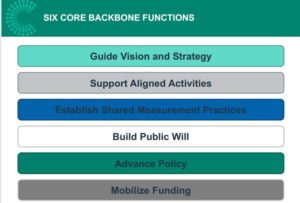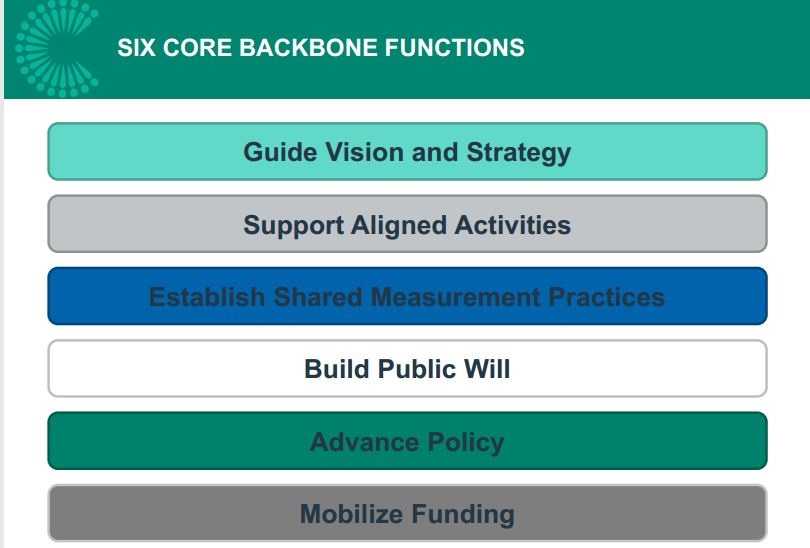FSG (co-author of the original Collective Impact article that helped spark the eponymous surge in collaborative efforts across the country) recently shared their thinking on how to evaluate progress in collective impact efforts. With Eastside Pathways now two years old, I thought it worth reflecting on how to evaluate our progress in the context of the framework presented in the FSG article.
FSG, together with the Aspen Institute and the Tamarack Institute, gathered some sixty leaders of collective impact efforts across a range of education, environmental, social service and other causes. They identified 27 measurable indicators of backbone effectiveness, grouped into the following six core functions:
 From my perspective, Eastside Pathways’ efforts have been focused, over the first two years, primarily on the top two components – establishing a shared vision for what we want to accomplish in our community and creating a coordinated approach to making progress toward that vision. The Campaign for Grade Level Reading is our best example of that effort.
From my perspective, Eastside Pathways’ efforts have been focused, over the first two years, primarily on the top two components – establishing a shared vision for what we want to accomplish in our community and creating a coordinated approach to making progress toward that vision. The Campaign for Grade Level Reading is our best example of that effort.
More recently, we’ve expanded our investment in creating shared measurement practices (see accompanying article), building on the work of the indicators/metrics teams of a year ago. I’m very excited about the progress we’re making and look forward to both sharing the results of our current work with partners and expanding the opportunity for more partner organizations to build the capacity to measure their contributions to our shared goals.
The area of building public will is our next focus area. We’ve made progress on draft plans and initial efforts for both community engagement and communications. Over the next six months, we look forward to expanding the conversation within our broad community around our key goals and the roles all of us can play to help attain them.
The final two roles – advancing policy and mobilizing funding – are areas that Eastside Pathways has limited intention to engage in, at least in the immediate term. It’s not that these areas aren’t important or potentially impactful. Rather, discussions with partners and community members have led us to conclude that, where we are in our development, we’ll make a greater impact elsewhere.
So that’s my take, as I look at our work through the lens of the FSG framework. But my view is not the important one. If you’re reading this article, you’re part of our community and part of our work. What’s your take on the progress we’ve made and our current areas of focus? Are we making the right decisions in terms of priorities, pace and trading off the various elements of backbone work in support of our collective goals? Share your views – we’re building our plan for next year and will take every one of your comments, critiques, and suggestions into account.
Thank you all for your engagement and support over the past two years – let it be the prelude to a surge of progress in the years to come.
Article submitted by Bill Henningsgaard, Executive Director, Eastside Pathways.

